| |

Traditions, folklore, history and more. If it's Irish, it's here. Or will be!
"People will not look forward to posterity who never look backward to their ancestors."
-Edmund Burke




Quotes
Library: Books, Movies, Music
Prints & Photos
Poetry
Jokes


Shops Ireland
Bunús na Gaeilge
(Basic Irish)
Circle of Prayer
Blessings
Did You Know?
Himself/Herself
Write to Us
Readers Write..
Links/Link to Us
Advertise with us
Awards & Testimonials
Submissions Guide

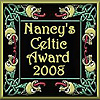
|
|
|
Cork - The Rebel County
by Bridget Haggerty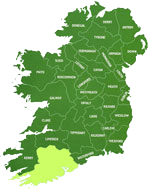

John Lloyd said of County Clare in 1780, "From its agreeable situation, the climate is remarkably wholesome, the air clear and temperate, and the prospect pure and delightful." Little has happened during the past two centuries to change this description. Today's Clare is a place of great natural beauty and historical and archaeological interest. It is a maritime county in the province of Munster, bounded on the west by the Atlantic, on the north-west by Galway Bay and on the east and south by the river Shannon. It is home to the Burren, the Cliffs of Moher and is a jumping off point for the Aran Islands.
The abundance of antiquities and archaeological remains which are scattered throughout the county are a legacy to the lives of its historic and pre-historic inhabitants. There are at least 2,300 earthen and stone forts, 130 megalithic tombs, 190 castles, 150 ancient churches, 3 cathedrals, 8 monasteries, 10 stone crosses, 5 round towers, and numerous lesser monuments. The county is fortunate in having areas of great natural beauty and superb scenery with many sandy beaches and sheltered bays. Loop Head is the most exposed promontory on the west coast and is of geological interest with some unusual rock formations. The near-by Bridges of Ross were formed by storm waves channelling into the caverns and creating natural arches which in time became separated from the mainland. The coast road around Black Head is a popular touring route, bounded on one side by the Atlantic and the Aran Islands, and on the other by the grey hills of the Burren.
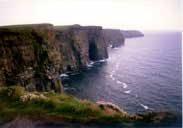 To the north of the county, the rugged Atlantic coast rises nearly 700 feet above the sea in the shape of the Cliffs of Moher. The majesty of the cliffs are well known. They are also a favorite nesting ground for flocks of sea birds and up to fifty species can be seen. These include fulmars, gannets, guillemots, shags, choughs (pronounced 'chuffs') and puffins. To the north of the county, the rugged Atlantic coast rises nearly 700 feet above the sea in the shape of the Cliffs of Moher. The majesty of the cliffs are well known. They are also a favorite nesting ground for flocks of sea birds and up to fifty species can be seen. These include fulmars, gannets, guillemots, shags, choughs (pronounced 'chuffs') and puffins.
In complete contrast, east Clare offers more gentle countryside, with many inviting lakes and streams. The river Shannon, and the vast expanse of Lough Derg, are host to boating and watersports of all kinds.
A Brief History
It is often said that County Clare is named after the de Clares. This is not the origin. The name comes from the Irish word Clár, meaning a board or plank. A board was placed across the river Fergus outside Ennis, at a place which was to become known as Clare, (now Clarecastle town). This Clare was a place of some importance as early as the 12th Century - thus predating the arrival of the de Clare family to the area.
The present county formed, from a very early period, a native principality, Tuath-Mumhan, or Thomond, signifying "North Munster". The area was divided into cantreds or baronies, each occupied by their ruling families. The O'Loughlins, O'Garbhs, O'Briens, O'Connors, O'Deas, McMahons and McNamaras were the main clans. Together, these families are generally referred to as the Dalcassian families, from Dal gCais, a name for the eastern half of the county.
The O'Briens were a major force in Thomond from earliest times. The Danish Vikings raided Clare on many occasions during the 9th and 10th centuries. They were finally defeated at the beginning of the 11th century by the most famous of the O'Briens, Brian Boru, who also led the army which defeated the Danes of Dublin at Clontarf in 1014.
Following the Norman invasion, Thomond was granted to Thomas de Clare who attempted to take control of the county but was eventually defeated by the O'Briens. The O'Briens were later made Earls of Thomond and thereby remained the major force in the county for centuries. The county boundaries were established by the English. In the period from 1568 - 1578 the Lord Deputy, Sir Henry Sydney, subdivided the existing region of Connacht into the counties of Clare, Galway, Mayo and Sligo. Clare, which in a physical sense, belongs more to Connacht than to Munster, was carved out of the mediaeval territory of the O'Brien's of Thomond. It was returned to Munster in 1639.
Following the defeat of the 1641 rebellion of the Catholic Confederacy, Clare was set aside to accommodate the "delinquent proprietors", i.e. those proprietors whose land was confiscated because they did not actively oppose the rebellion. Parts of the lands of the existing Clare landholders were confiscated to accommodate these landholders.
The county was badly affected by the Great Famine of 1845-47. The population was 286,000 in 1841 and by 1851 had been reduced to 212,000. Over 50,000 people died between 1845 and 1850 and many others emigrated to the United States and Australia. The decline in population continued during the subsequent one hundred years, falling to 73,500 in 1966. A gradual increase has been occurring since then and the 1991 census recorded a population of 91,000.
Why is Clare called 'The Banner County'? The custom of carrying banners goes back a long way. There is little doubt that the Dal gCais carried banners at the battle of Clontarf in 1014 or that the Clare Dragoons carried banners at Fontenoy in 1745 and in the many battles fought by the Clare Regiments on the continent during the eighteenth century. However, the name 'the banner county' would appear to be of recent origin. In the last century as the population became more politicized, the custom of carrying banners to political meetings became widespread. Many banners welcomed Daniel O'Connell at the Clare election of 1828 and the freeholders marched behind banners to the Ennis courthouse to cast their votes for O'Connell on that occasion.1
In Ennis, most trade guilds had their own banners: bakers, butchers, brogue makers, coopers, nailers, dyers, masons, harness makers, cartwrights, stone cutters etc. all competed to produce the most handsome of banners. At the inauguration of the O'Connell monument in Ennis in 1865. thirteen different guilds carried banners, each representing the attributes of their particular trade.
 Co. Clare's colors of blue and gold were the colors reputedly carried by Brian Boru at the Battle of Clontarf in 1014. In 1986, the Council introduced a Coat of Arms signifying six symbols relevant to the county with the principal colors of the shield (azure and blue) grounded on blue and gold.The heraldic design reflects Clare's topography, history and achievements. The shield conveys both the flat and craggy landscape. The six compartments into which the shield is divided are intended to represent the six ancient areas - Dal gCais, Clann Cuilean, Ui Caisin, Corcumrua, Corca Baiscinn and Ui Breacain, that make up the present day county. The rose motif, which has been abstracted from the shield of the old diocese of Kilfenora typifies the Burren. The tau cross (Kilnaboy) was chosen to represent Clare's rich heritage of antiquity. The antique Irish Crown symbolizes the ancient Kingdom of Thomond, which was most of the present County. The pile reversed fleuried at the point is suggestive of aircraft lift-off over the Shannon River, thereby symbolizing Shannon International Airport.The wavy effect at the base of the shield suggests the River Shannon; a boundary feature for so much of the area. The stag's head is intended to commemorate the many Clare families whose shield and crests bear this motif, including Meehan, Curtin, Cullinan, Hehir, O'Connor, O'Connell and many others.The circle of fire symbolizes the electricity-producing installations - Moneypoint and Ardnacrusha. for example. The winning motto for the Coat of Arms 'Dílis d'ar nOidreacht' (True to our heritage) was the suggestion of Miss Rebecca Maher, 11 Woodlawn, Lahinch Road, Ennis, after the Council invited applications from the various schools for appropriate slogans. Co. Clare's colors of blue and gold were the colors reputedly carried by Brian Boru at the Battle of Clontarf in 1014. In 1986, the Council introduced a Coat of Arms signifying six symbols relevant to the county with the principal colors of the shield (azure and blue) grounded on blue and gold.The heraldic design reflects Clare's topography, history and achievements. The shield conveys both the flat and craggy landscape. The six compartments into which the shield is divided are intended to represent the six ancient areas - Dal gCais, Clann Cuilean, Ui Caisin, Corcumrua, Corca Baiscinn and Ui Breacain, that make up the present day county. The rose motif, which has been abstracted from the shield of the old diocese of Kilfenora typifies the Burren. The tau cross (Kilnaboy) was chosen to represent Clare's rich heritage of antiquity. The antique Irish Crown symbolizes the ancient Kingdom of Thomond, which was most of the present County. The pile reversed fleuried at the point is suggestive of aircraft lift-off over the Shannon River, thereby symbolizing Shannon International Airport.The wavy effect at the base of the shield suggests the River Shannon; a boundary feature for so much of the area. The stag's head is intended to commemorate the many Clare families whose shield and crests bear this motif, including Meehan, Curtin, Cullinan, Hehir, O'Connor, O'Connell and many others.The circle of fire symbolizes the electricity-producing installations - Moneypoint and Ardnacrusha. for example. The winning motto for the Coat of Arms 'Dílis d'ar nOidreacht' (True to our heritage) was the suggestion of Miss Rebecca Maher, 11 Woodlawn, Lahinch Road, Ennis, after the Council invited applications from the various schools for appropriate slogans.
Important Attractions
Ballyalla Lake
A fair-sized lake on the River Fergus, it is a short distance from Ennis off the Gort road (N18). Follow the signs left for Ruan. There is a riverside park with picnic facilities, restrooms and car park. The lake, although small for the purpose, is usable for dinghy sailing. Ballyalla has some features for those interested in wildlife and aquatic plants. Wintering wild-fowl frequent the lake and surrounding grassland. Ballyalla Castle, now demolished, figured prominently in a siege of 1642.
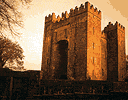 Bunratty Castle & Folk Park Bunratty Castle & Folk Park
Bunratty Castle is the most complete and authentic medieval castle in Ireland. Built in 1425, and plundered on many occasions, it was authentically restored in 1954 to its former medieval splendor, with furnishings and tapestries capturing the mood and style of the times. Famous Medieval Banquets are held nightly. Within its grounds is Bunratty Folk Park, where Irish village life at the turn of the century is recreated.
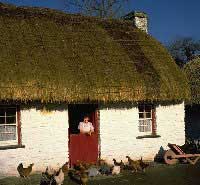 The Folk Park contains typical 19th century rural and urban dwellings. There are eight farmhouses, a watermill, a blacksmith’s forge, a village street complete with pub, post office, school, doctor’s house, hardware shop, printers, drapery shop, pawn shop and village hotel. In the park, you can see traditional crafts such as bread baking, knitting, weaving, and pottery in their natural setting. When we were there, we stopped by Durty Nellies pub for a quick one before going to the banquet. Our advice is to skip this pub which is always crowded to over-flowing in tourist season. Instead, we recommend Mac's which is the favorite of the locals. We went there after the banquet and thoroughly enjoyed traditional Irish music, singing and dancing. It was our last night in Ireland - and a perfect way to end our vacation. The Folk Park contains typical 19th century rural and urban dwellings. There are eight farmhouses, a watermill, a blacksmith’s forge, a village street complete with pub, post office, school, doctor’s house, hardware shop, printers, drapery shop, pawn shop and village hotel. In the park, you can see traditional crafts such as bread baking, knitting, weaving, and pottery in their natural setting. When we were there, we stopped by Durty Nellies pub for a quick one before going to the banquet. Our advice is to skip this pub which is always crowded to over-flowing in tourist season. Instead, we recommend Mac's which is the favorite of the locals. We went there after the banquet and thoroughly enjoyed traditional Irish music, singing and dancing. It was our last night in Ireland - and a perfect way to end our vacation.
The Burren National Park
This is a magnificent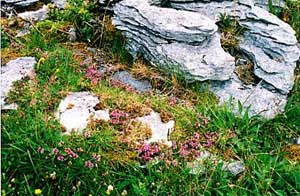 karst limestone area with a combination of many unusual features that make it one of the most unique regions in Europe. Its geology, rare alpine flora, fauna, caves, archaeology, and history set it apart as a place of great mystery and beauty. karst limestone area with a combination of many unusual features that make it one of the most unique regions in Europe. Its geology, rare alpine flora, fauna, caves, archaeology, and history set it apart as a place of great mystery and beauty.
 In a relatively small area, there are wonderful rivers, castles, peaceful lakes, towering cliffs, lush green valleys, barren rock mountains, green road walks - and constant relics of ancient civilization; round towers, stone arches, ancient churches, high crosses, crannogs, tombs, great houses, monasteries, holy wells and dolmens - including the famous 5000-year-old Poulnabrone Dolmen. In a relatively small area, there are wonderful rivers, castles, peaceful lakes, towering cliffs, lush green valleys, barren rock mountains, green road walks - and constant relics of ancient civilization; round towers, stone arches, ancient churches, high crosses, crannogs, tombs, great houses, monasteries, holy wells and dolmens - including the famous 5000-year-old Poulnabrone Dolmen.
The southern section of the Burren is characterized by seasonal lakes called turloughs, which ebb and fill as the region's water table changes. Gradually, rainwater falling on this limestone plateau finds its way underground into a maze of caves and subterranean channels.
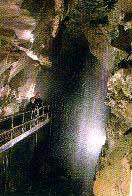 While most of the Burren cave are too dangerous for novice investigations, Aillwee Cave in Ballyvaughan has been opened and is well worth seeing. Highly trained expert guides accompany visitors at all times and take them on a 30-minute stroll through beautiful caverns over bridged chasms, under strange formations, and alongside the thunderous waterfall which can sometimes gently spray the unsuspecting spectator. Before returning to the outside world, the tour continues on by the frozen waterfall and then on to the hibernation chambers of the long since extinct brown bears. After the tour, visitors are free to climb over the typical Burren limestone pavements above the cave to see the spring gentian or mountain avens blooming in profusion. While most of the Burren cave are too dangerous for novice investigations, Aillwee Cave in Ballyvaughan has been opened and is well worth seeing. Highly trained expert guides accompany visitors at all times and take them on a 30-minute stroll through beautiful caverns over bridged chasms, under strange formations, and alongside the thunderous waterfall which can sometimes gently spray the unsuspecting spectator. Before returning to the outside world, the tour continues on by the frozen waterfall and then on to the hibernation chambers of the long since extinct brown bears. After the tour, visitors are free to climb over the typical Burren limestone pavements above the cave to see the spring gentian or mountain avens blooming in profusion.
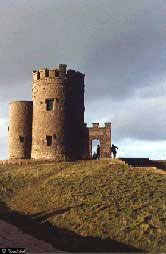 Cliffs of Moher & O'Briens Tower Cliffs of Moher & O'Briens Tower
Just north of Lahinch, on the coast of West Clare, are the famous Cliffs of Moher, defiantly standing as giant natural ramparts against the aggressive might of the Atlantic Ocean. The Cliffs of Moher (Great Wall of Thomond) and O'Brien's Tower, which stands out on a headland, shows the extent of the O'Brien influence on the area. The tower was built in 1835 by Cornelius O'Brien as an observation point for the hundreds of tourists who even then visited the Cliffs. Cornelius was a man ahead of his time, believing that the development of tourism would benefit the local economy and bring the people out of poverty. O'Brien's Tower was not his only project - in fact it's said of him that 'He built everything around here except the Cliffs'
Ennis
Clare’s principal town is Ennis, a busy market centre on the River Fergus. Its famous narrow streets are dotted with a host of unusual shops, bars and restaurants. While Ennis is regarded as the heartland of Irish music, it's also an ideal centre for touring around County Clare. Whether you'd like to banquet at 15th century Bunratty Castle, visit the delightful lakes of East Clare, or explore the isolated Loop Head coastline, everything is a short drive away.
Lahinch
Formerly known as Leath Inse, or peninsula, from its water-bound location, its present Irish name derives from a prominent member of the O'Connor clan who is buried here. Lahinch, some 3 km west of Ennistymon is a very popular holiday resort, noted for its bathing beach and even more famous for its championship links and 18-hole golf course. There is a promenade facing the Atlantic. An Entertainment Centre beside the promenade is open during tourist season and offers varied entertainment from bingo to traditional music. The beach offers excellent surfing. Some distance north of Lahinch, at O'Brien's Bridge, are the remains of Dough Castle, built by Donnchadh O'Connor in 1422, and later appropriated by the O'Briens.
Lisdoonvarna
To learn more about the "Match-Making Capital of Europe, see our article: Making a Match in Lisdoonvarna.
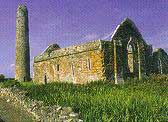 Scattery Island Scattery Island
"The island of battles" is an incorrect transaltion of Scattery Island's ancient name, Inis Cathaigh, the Island of the Cathach - a legendary sea-serpent. Right or wrong, it is a fitting name for a place that has seen so much bloodshed. As legend has it, the Cathach had his lair on the island. He terrorised the inhabitants of the surrounding region from here until he was banished by St. Senan and imprisoned beneath the waters of Doo Lough, near Mount Callan. Viking raids were a frequent occurrence until the Vikings of Limerick settled on the island. This small island in the mouth of the Shannon, just out from Kilrush, encapsulated the history of ecclesiastical Ireland. During the sixth century St. Senan, the patron saint of West Clare, founded a monastic establishment here which developed into collegiate church. Today, one can walk around Scattery in a few hours and gaze on the ruins of a fine round tower, four churches, a castle, a battery dating from Napoleonic times, and the remains of a village deserted by the last of its inhabitants in 1978.
Famous People with Clare Connections
Brian Boru - High King of Ireland.
Former President of Ireland, Patrick Hillary.
U.S. Senator, Chris Dodd.
Frederick William Burton, former director of British National Gallery.
John Holland, inventor of the modern submarine.
Michael Cusack, the founder of the Gaelic Athletic Association.
Paddy Hannon, who discovered the Golden Mile in Australia.
The "Liberator", Daniel O'Connell.
Eamon De Valera, former President of Ireland.
Archbishop Clancy of Melbourne.
Durack Family, Australia
Finding your Clare Ancestors
Early Clare emigrants to the U.S.A. settled chiefly in Wisconsin, Iowa, Illinois, Ohio and New Orleans. Later emigrants from Co. Clare to the U.S.A. settled in New York, New Jersey, Boston and Philadelphia. Emigration from County Clare was not, however, confined solely to the United States. County Clare has strong ties with Australia. In the years 1849 to 1869 over 6,000 County Clare emigrants arrived in Sydney.
The Clare Heritage Centre pioneered the development of family history research in Ireland and has now computerized records on half a million people who were born or married in Co Clare before 1900.
Attached to the Genealogical Centre is a visitors' museum which portrays the traumatic period of Irish history from 1800 to 1860 - Ireland before, during and after the Great Famine.
The Centre provides a Full Service. For more information, write to Clare Heritage and Genealogical Centre Church Street, Corofin, Co Clare, Ireland or visit them on the web Clare Heritage Centre.
Some Clare Surnames
The chief surnames of the county include: McMahon, McNamara, Moloney, O'Brien, McInerney, Ryan, Kelly, Keane, O'Connor, O'Halloran, Hogan, Lynch, Murphy and Burke.
1NOTE: We received the following information from Tony, one of our subscribers, who offers a personal perspective on what the term "Banner County" means to him.
"I liked your article a lot - not only well-informed but well-written. Also I never knew previously that Clare was named after a plank bridge at Ennis. I'd often puzzled over the name, but finally assumed that it was because of the flat south-western portion of the county. This now explains the several other clares such as Cooraclare and Claregalway.
...although you mentioned banners, you did so more as a general comment on people marching under them (including the election of Dan O'Connell).
However in this case the 'banner' (of Catholic Emancipation) is a figurative one rather than a literal one.
My village (Corofin) was the banner village. Father John Murphy (not the famous one of the '98 in Wexford who was already long dead) fired up the people of Corofin to such an extent that they decided to march en masse to Ennis to vote, even though the vote was public, and the landlords had threatened eviction for anyone who voted for O'Connell. It is 13 kilometres from Corofin to Ennis, and as the Corofin men passed people galloped round the county on horseback with the news that they were voting. This inspired the rest of Clare and led to O'Connell's victory. So I feel a very personal connection to the name, (Banner County), even though I now live in Belgium, and haven't lived in Ireland since 1960."
Resources:
Content:
Go Ireland
 Tour Clare Tour Clare
Clare Library
Images:
Clare Coastline by kind permission of: John Kehely, Keewi Photography
Flowers of the Burren & Poulnabrone with the kind permisssion of Christophe Losberger.
|
|
Thu, Apr 4, 2024
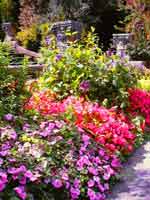 Ilnacullen, Co. Cork - an Island Garden Ilnacullen, Co. Cork - an Island Garden
Located in the sheltered harbour of Glengarriff in Bantry Bay. Ilnacullin, which means island of holly, is a small island known to horticulturists and lovers of trees and shrubs all around the world as an island garden of rare beauty.
The vivid colours of Rhododendrons and Azaleas reach their peak during May and June, whilst the hundreds of cultivars of climbing plants, herbaceous perennials and choice shrubs dominate the midsummer period from June to August.
Because of its sheltered situation and the warming oceanic influence of the Gulf Stream, the climate is favourable to the growth of ornamental plants from many parts of the world.
Even for those who aren’t particularly interested in gardens, there are many other scenic views, especially in the surrounding waters where seals frequent the rocks on the southern shore.
The cover photo on Bridget's book The Traditional Irish Wedding shows a wrought iron garden gate on Ilnaculen. I took that photo. To see it, go to the home page. It's part of the opening paragraph Failte.
—Russ
Resource: Copy and Image - Cork Guide
Click for More Culture Corner.
|
Celtic Odyssey
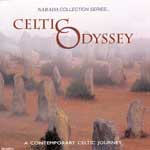
We never tire of listening to this Narada compilation. It's been out a while, but we can still remember the thrill of listening to it for the first time. From Carolan's Ramble to Cashel by Northern Lights to Strathgarry by Simon Wynberg, every cut has become a favorite. Some might say it's "New Age Celtic" - but, no matter. Amazon gives you the opportunity to judge for yourself; click Celtic Odyssey.
|
|
|
|
|




 Ilnacullen, Co. Cork - an Island Garden
Ilnacullen, Co. Cork - an Island Garden